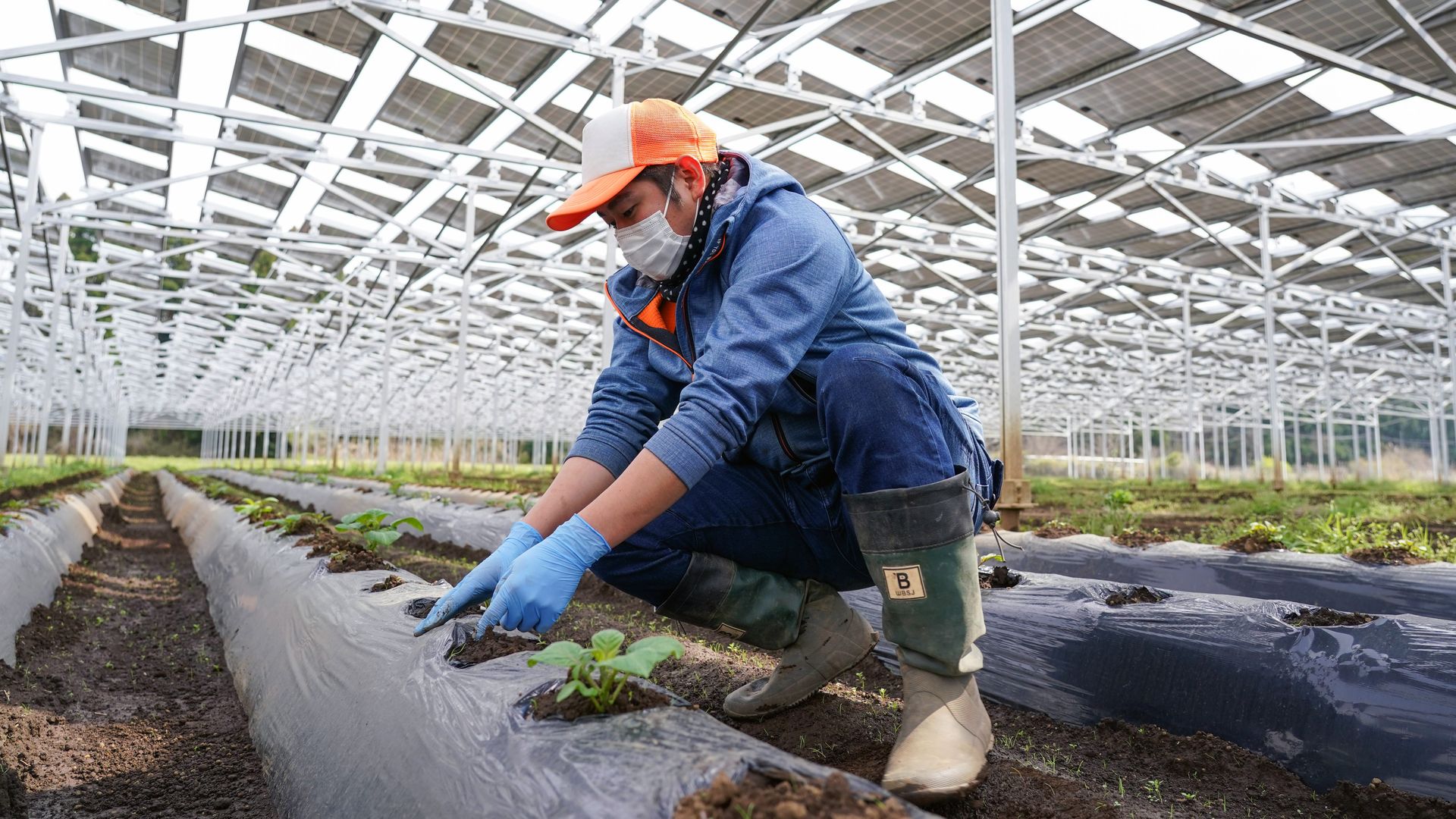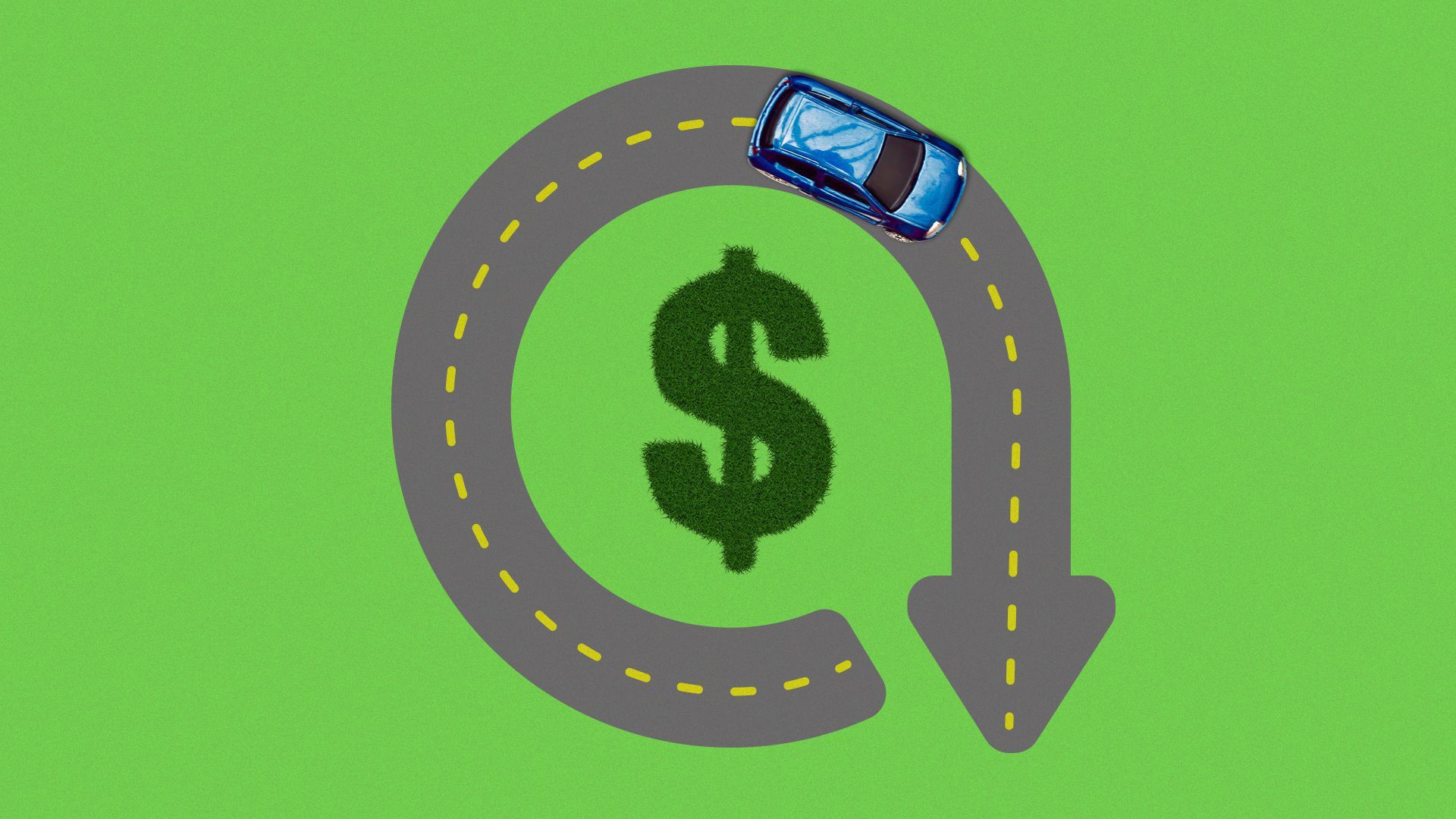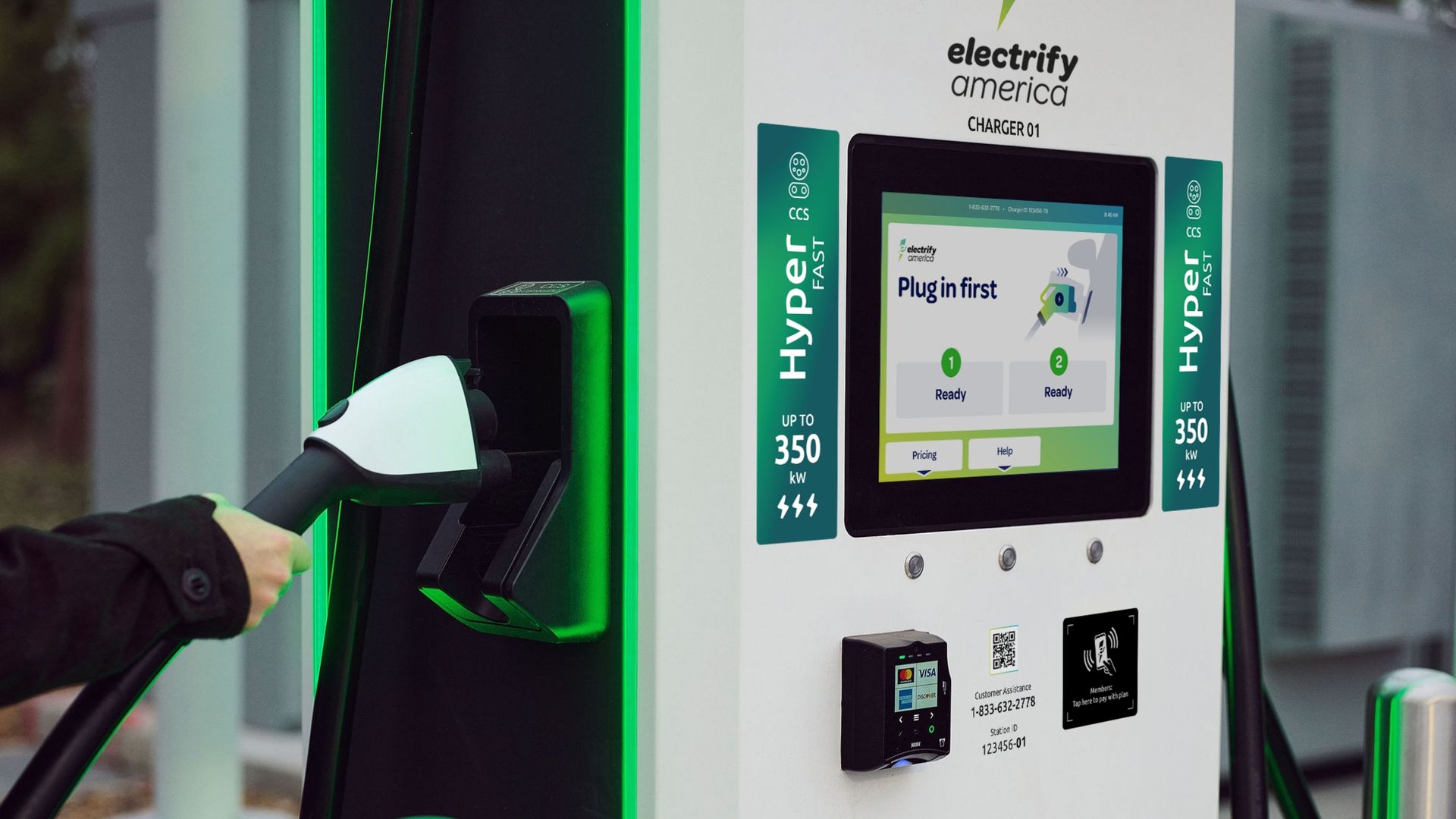| | | | | | | | | | | Axios What's Next | | By Alex Fitzpatrick, Jennifer A. Kingson and Joann Muller · Sep 12, 2022 | | Alex here. Today's story is another entry in the "solar panels cropping up in unexpected places" file. - Have you seen exciting, innovative alternative energy projects in your neighborhood or travels? Tell us about them: whatsnext@axios.com.
Today's newsletter is 1,106 words ... 4 minutes. | | | | | | 1 big thing: Farming for solar power |  | | | A worker at an agrivoltaic farm in Chiba, Japan. Photo: Toru Hanai/Bloomberg via Getty Images | | | | Farmers and researchers are experimenting with installing solar panels over active agricultural land in an emerging field called agrivoltaics, Alex Fitzpatrick reports. Why it matters: As the world seeks to wean itself off fossil fuels, solar power will indisputably be part of the post-carbon energy mix. - Yet there's only so much land that can be effectively converted to single-use solar production, so dual-use projects like agrivoltaics are getting a closer look.
- For farmers — many of whom are facing an uncertain future as the climate changes — the hope is that "farming" for solar power can be an additional money-maker.
How it works: Solar panels installed over farmers' crops generate electricity that can then be sold to an energy supplier and fed into the power grid for community use. - Crops that thrive in the shade — think leafy greens like kale and lettuce, or root vegetables like radish and beets — are protected from harsh direct sunlight.
- Plants, meanwhile, naturally give off water vapor that can help cool solar panels from below, improving their efficiency.
State of play: U.S. agrivoltaic pilot programs are afoot in: - Rockport, Maine, where University of Maine researchers are studying the impact of solar panels installed over 11 acres of blueberry farmland.
- Grafton, Massachusetts, where farmers are working with University of Massachusetts academics to figure out which crops perform best under solar panels' shade.
- And Longmont, Colorado, home to Jack's Solar Garden, which considers itself the country's largest commercially active site for agrivoltaics research.
Be smart: Farms' fundamental purpose has always been converting the sun's rays into energy. That energy has historically taken the form of calories — but agrivoltaics makes it possible for farmers to diversify their energy output, says Chad Higgins, an associate professor at Oregon State University's College of Agricultural Sciences. - "Do they want to create electrons in the form of electricity? Or do they want to create calories in the form of food, or a mixture of both? What's the most profitable for them? What's best for them, given their available other resources?"
Yes, but: Some farmers are skeptical, mostly due to practical concerns. It can be hard to drive a tractor in and around a bunch of solar panels, for instance. - The upfront cost of installing lots of solar panels can be prohibitive — although some states, like Massachusetts, are experimenting with financial incentives.
- That's trickier than it might sound. If producing solar power becomes dramatically more profitable than growing crops, and lots of farmers switch mostly or fully to solar, food shortages could follow.
- Whether it makes sense for a farm to add solar also depends on whether there's an electric substation nearby. The further a substation, the more energy is lost in transmission — meaning it won't be economical to sell power into the grid.
What's next: As researchers and early adopters figure out the best crops, tools and techniques to use — and more state, local and national governments support agrivoltaic efforts — expect to see lots more solar panels over the world's farmland in the coming years. Share this story. |     | | | | | | 2. Companies (quietly) drop vax rules |  | | | Illustration: Sarah Grillo/Axios | | | | Some companies are rolling back mandates for employee COVID-19 vaccination — but few are making official public statements about it, Axios' Emily Peck reports. Why it matters: These moves signal that we've shifted into a new chapter of the pandemic — and that employers are desperate to get people back to the office. Yes, but: There's a risk that dropping these requirements would make some workers less willing to mingle with their colleagues, for fear of becoming sick. Companies mostly don't want to talk about this, seeing little upside given mandates' controversial history. But a few large employers' plans are public: - Starting this week, Goldman Sachs lifted vaccination requirements everywhere but New York City, which still has a mandate for workplaces.
- In June, Cisco stopped requiring vaccination for "office entry, travel, event attendance, or visiting customers, partners, and other third parties," per its website.
- JPMorgan Chase said it would start hiring unvaccinated individuals again in March.
The bottom line: We're in a new era — for now. Everyone's watching to see what happens with cases in the fall. Read the rest. |     | | | | | | 3. Used cars could get cheaper again |  | | | Illustration: Rae Cook/Axios | | | | The haywire period in used-vehicle prices may finally be coming to an end, Axios' Nathan Bomey reports. Why it matters: The pandemic's supply chain disruptions sent used-car values upward, in a shocking twist for something long considered a depreciating asset. Driving the news: Wholesale used-vehicle prices — what dealers pay at auction — fell 4% in August compared with July, according to Cox Automotive's Manheim Used Vehicle Value Index. - At 210.8, the Manheim index marked its sixth decline in the last seven months and its lowest point since December.
The big picture: Wholesale price movement typically precedes retail price movement — meaning used-vehicle prices could soon fall. Read the rest. |     | | | | | | A message from Axios | | Internal updates that engage your busiest teams | | |  | | | | Communications that keep hybrid staff focused and engaged should: - Meet staff where they are- often, on email
- Speak to them like a smart friend, not a subordinate
- Be transparent and empathetic, always
Get inspired by Jim's weekly business update to Axios staff. | | | | | | 4. Germany's cheap trains were a huge hit |  | | | Travelers stand on a rail platform in Dortmund, Germany, on June 1. Photo: Ina Fassbender/AFP via Getty Images | | | | German transit officials sold 52 million tickets for 9 euros ($9.02) a month that were good for unlimited train, bus and subway travel across the country between June and August, Bloomberg reports. - "20% [of] those tickets went to people who wouldn't normally use public transit," and "the resulting reduction in car trips saved an estimated 1.8 million tons of carbon emissions," per Bloomberg.
Why it matters: It's a big sign that when public transit is made affordable, people respond in droves. Yes, but: The program was far from cheap, costing Berlin about 2.5 billion euros ($2.5 billion). What's next: Fares are on their way back up, but officials may introduce a similar all-you-can-ride monthly fare for somewhere between 49 and 69 euros. |     | | | | | | 5. EV charging made simpler |  | | | Courtesy of Electrify America | | | | Electrify America, which has about 800 electric vehicle (EV) charging stations across the U.S., is relabeling its chargers to make it more clear how much power they offer, Alex Fitzpatrick reports. Why it matters: EV charging can be pretty confusing, especially for newbies used to the regular/plus/premium gasoline world. Details: The company's chargers will be designated "ultra-fast" for power delivery of up to 150 kW (about nine miles of range per minute of charging, depending on the vehicle) or "hyper-fast" for up to 350 kW (about 20 miles of range per minute). - Ultra-fast chargers will have a teal label and two bolt icons, while hyper-fast gets green and three bolts.
- Some EVs can charge more quickly than others, meaning they would benefit from "hyper-fast," while others would max out with "ultra-fast."
Alex's thought bubble: Anything that makes the sometimes mystifying world of EV ownership more straightforward is a win in my book. |     | | | | | | A message from Axios | | Internal updates that engage your busiest teams | | |  | | | | Communications that keep hybrid staff focused and engaged should: - Meet staff where they are- often, on email
- Speak to them like a smart friend, not a subordinate
- Be transparent and empathetic, always
Get inspired by Jim's weekly business update to Axios staff. | | | | A hearty thanks to What's Next copy editor Kathie Bozanich. Was this email forwarded to you? Get your daily dose of What's Next by signing up here for our free newsletter. |  | | Are you a fan of this email format? It's called Smart Brevity®. Over 300 orgs use it — in a tool called Axios HQ — to drive productivity with clearer workplace communications. | | | | | | Axios thanks our partners for supporting our newsletters. If you're interested in advertising, learn more here.
Sponsorship has no influence on editorial content. Axios, 3100 Clarendon Blvd, Arlington VA 22201 | | | You received this email because you signed up for newsletters from Axios.
Change your preferences or unsubscribe here. | | | Was this email forwarded to you?
Sign up now to get Axios in your inbox. | | | | Follow Axios on social media:    | | | | | |










No comments:
Post a Comment